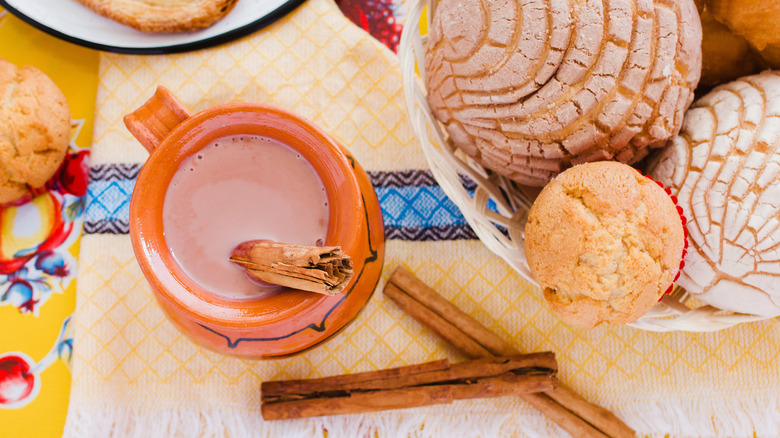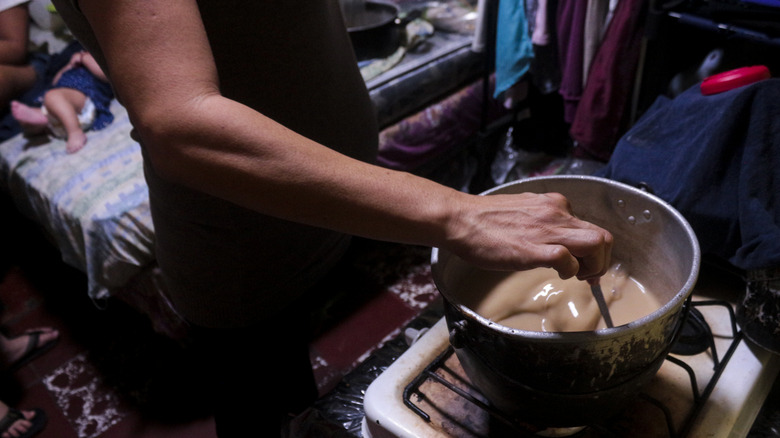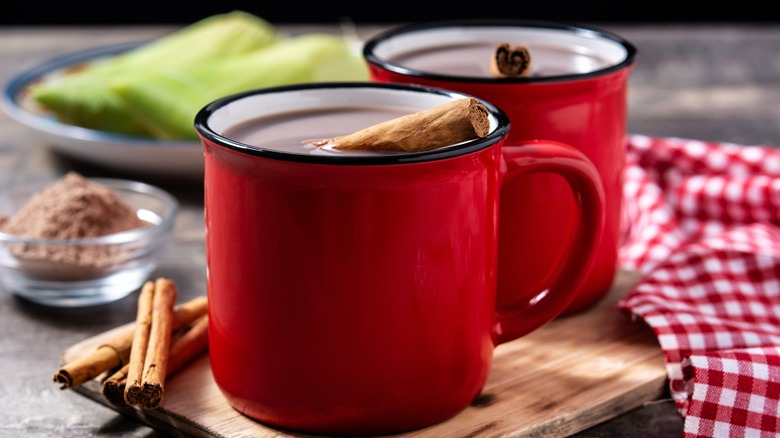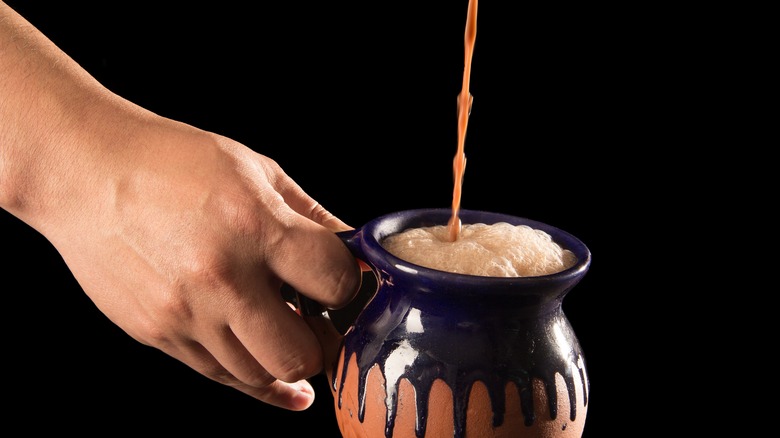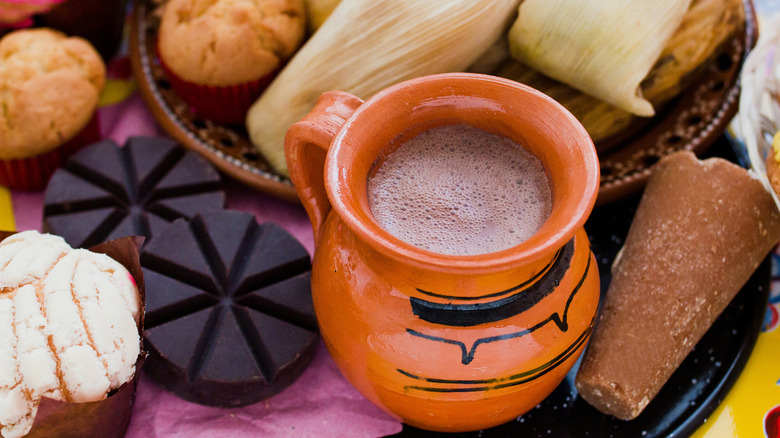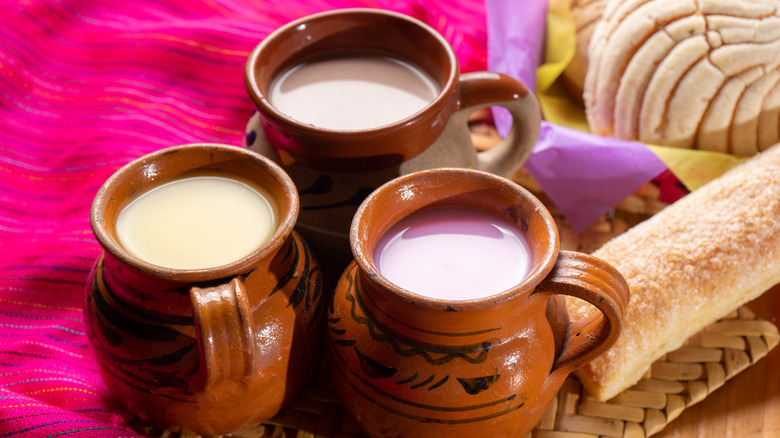Chocolate-Atole: The Oaxacan Drink That Uses A Rare Type Of Cocoa
Mission Chocolate Recipe describes the chocolate-atole as not only the most prized and valued chocolate drink made in Oaxaca but also the most complicated drink in all of Latin America. A pretty big claim, if you ask us.
Chocolate-atole is like being served two drinks in one, according to Slurrp. Warm atole rests on the bottom of a mug, and frothy foam is perched on top. Think of a cappuccino, and you'll get the idea. Atole by itself is a dense, thick drink made from ground corn dough and water. It can be found in stores and markets throughout Mexico and can be ordered in different varieties, with berries, nuts, or chocolate adding unique flavors to the drink. Chocolate-atole, however, isn't found as easily.
Chocolate-atole is prepared specifically for special events and occasions. Served alongside traditional Mexican sweet bread conchas, chocolate-atole is a unique drinking experience — there's a reason this drink has been enjoyed for centuries.
The history of chocolate-atole
Cacao trees are listed in ancient Mayan text, and beverages made with beans from cacao trees have been made since pre-Hispanic times, notes Atlas Obscura. In fact, these drinks were so revered that Mayans engraved vessels and vases with recipes and instructions on how to make some of the more traditional cocktails (via Academia).
The word "atole" has been used for centuries and is derived from Nahuatl, an Aztecan language, notes the Chicago Tribune. Mixing water with ground corn was an easy way to get some calories in; Surviving Mexico explains these kinds of drinks became part of Mexican hospitality, and guests would be served beverages made specifically for their arrival.
Yet chocolate-atole has cemented itself as a drink associated with celebration and ceremony, even sneaking its way into weekend markets at the insistence of children who enjoy its foamy texture. If you're a fan of any of the chocolate drinks served at Starbucks, the chocolate-atole may send your tastebuds into a spin — and there's one ingredient that's responsible for the unique recipe.
A special ingredient
You may already have decided on your favorite type of chocolate, but the kind that is added to chocolate-atole might be a variety you haven't yet tried. Most connoisseurs are familiar with the various types of chocolate, but pataxte isn't as well known, but it is a key addition to chocolate-atole. Atlas Obscura details that this "white chocolate" isn't typically found outside of Central or South America, as the production process is a bit complicated. Pataxte seeds are harvested throughout the year and then planted underground to ferment; after one or two years, the seeds are dug back up, washed, set into the sun to dry, then ground into a fine, white powder.
Because of this lengthy process, pataxte can be hard to come by. When you do find it, the ingredient is usually expensive to purchase (via Slurrp). Pataxte has less caffeine than regular chocolate but is higher in fat — this is part of the reason why it is ideal for making frothy, foamy drinks like the chocolate-atole.
How chocolate-atole is made
Making chocolate-atole isn't a fast production; the drink can take months to assemble thanks to pataxte, but without pataxte, chocolate-atole wouldn't have the foamy top layer the drink is known for. After pataxte has been dried, fermented, and ground into a powder, it is then mixed with cinnamon, ground corn, and ground cacao, per Atlas Obscura. Without adding any liquid, this blend of ingredients can be set onto a shelf to be made into the drink at a later time (via Mission Chocolate Recipes). Think of this mixture as similar to a gingerbread hot chocolate recipe that has been made in advance and is just waiting for the addition of milk.
You'll need some patience and stamina to produce a chocolate-atole. Atlas Obscura explains you'll first mix your ground ingredients with water and use a wooden whisk (called a molinillo) to whip the concoction into a foamy texture. Once you've accumulated a fair amount of foam, Mission Chocolate Recipes explains, spoon off some of the foam and set it to the side. The goal is to whisk up a decent amount for your drinks.
Next, you'll boil corn, water, and sugar into an oatmeal-like consistency. This is the atole, and it will be first set into your cup before topping with the foam you've made. However, as Mission Chocolate Recipes directs, no cup of chocolate-atole is complete without a wooden mixer (alcahuete), which chocolate-atole drinkers use to stir the two layers together before enjoying.
How to enjoy chocolate-atole
"The drink is surprising because it doesn't taste like chocolate. The flavor is delicate, it's not sweet, it has notes of nuts like almonds, and it feels thick and buttery," James Beard Award-winning chef Iliana de la Vega told Atlas Obscura. And that flat wooden stick that is always served alongside the beverage? It is often carved into the shape of an animal and painted in bright colors. However, even these fun decorations fail to distract from chocolate-atole's unique taste (via Slurrp). Though you'd think the beverage would taste more like a hot chocolate recipe, it's actually more nutty and dense.
Rutopia recommends that chocolate-atole be accompanied by traditional Oaxacan egg or butter bread. And as Atlas Obscura reminds eager drinkers, the bottom portion of the chocolate-atole is unflavored, so you can decide whether to enjoy each part as a distinct experience or to mix the foam and atole together to drink.
Atole alternatives
If you're not sure about the frothy chocolate combination or are looking for other comforting beverages to try, atole has variations. Traditionally, atole is made with corn with a bit of sugar, cinnamon, and vanilla, but you can find atole in other flavors, as suggested by Things to do in Oaxaca, and different recipes can yield varying tastes and textures.
Atole can be made with milk instead of water, lending a creamier, sweeter taste to the beverage. For chocolate lovers, instead of the foamy chocolate-atloe we've been temping you with, you can also order a champurrado, which is atole with chocolate mixed directly into the recipe.
No matter which variety you sample, these drinks can run hot. And with any steaming beverage, the right treat served alongside your mug can deliver a snack that will turn even the gloomiest of days right-side up. For colder mornings, we recommend this spicy chocolate cake recipe or a hot chocolate bomb to serve with your drink.
